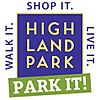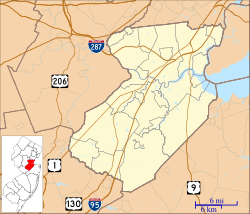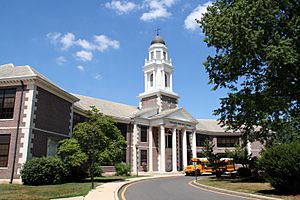Highland Park, New Jersey facts for kids
Quick facts for kids
Highland Park, New Jersey
|
||
|---|---|---|
|
Borough
|
||
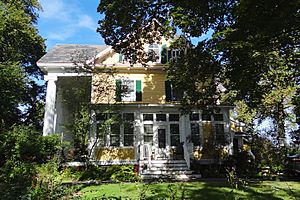
Livingston Homestead, Highland Park, NJ south view.
|
||
|
||
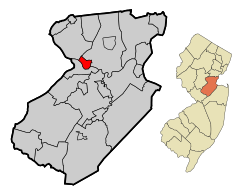
Location of Highland Park in Middlesex County highlighted in red (left). Inset map: Location of Middlesex County in New Jersey highlighted in orange (right).
|
||
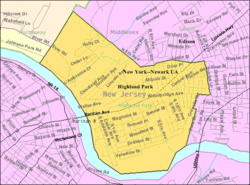
Census Bureau map of Highland Park, New Jersey
|
||
| Country | ||
| State | ||
| County | Middlesex | |
| Incorporated | March 15, 1905 | |
| Government | ||
| • Type | Borough | |
| • Body | Borough Council | |
| Area | ||
| • Total | 1.83 sq mi (4.74 km2) | |
| • Land | 1.82 sq mi (4.72 km2) | |
| • Water | 0.01 sq mi (0.02 km2) 0.44% | |
| Area rank | 424th of 565 in state 21st of 25 in county |
|
| Elevation | 75 ft (23 m) | |
| Population
(2020)
|
||
| • Total | 15,072 | |
| • Estimate
(2023)
|
14,959 | |
| • Rank | 174th of 565 in state 16th of 25 in county |
|
| • Density | 8,276.8/sq mi (3,195.7/km2) | |
| • Density rank | 46th of 565 in state 3rd of 25 in county |
|
| Time zone | UTC−05:00 (Eastern (EST)) | |
| • Summer (DST) | UTC−04:00 (Eastern (EDT)) | |
| ZIP Code |
08904
|
|
| Area code(s) | 732 / 908 | |
| FIPS code | 3402331470 | |
| GNIS feature ID | 0885252 | |
Highland Park is a small town, called a borough, in Middlesex County, New Jersey. It's part of the larger New York City metropolitan area. This borough sits on the north side of the Raritan River. In 2020, about 15,072 people lived here.
Highland Park became an official borough on March 15, 1905. It separated from what was then called Raritan Township, which is now Edison. The town got its name because it's located on high land overlooking the Raritan River.
Contents
Highland Park's Story: A Look Back
The first people to live in the Highland Park area were the Lenape Native Americans. They used to hunt in the hills along the Raritan River. Their trails connected the Delaware River and Hudson River areas.
In 1685, a man named John Inian bought land on both sides of the Raritan River. He started a ferry service, and the main road was changed to lead to his ferry. This river crossing was used for many years. A toll bridge replaced the ferry in 1795. The current stone arch bridge, which is 595 feet long, was built in 1892. It became part of the Lincoln Highway in 1914.
One of the first European settlers was Henry Greenland in the late 1600s. He owned almost 400 acres of land and ran an inn. Other early settlers included the Drake family. In the early 1700s, some wealthy Europeans also settled here, creating isolated farms.
In 1809, Reverend John Henry Livingston bought 150 acres of land. This area became known as the Livingston Manor. The Livingston Homestead, a beautiful Greek Revival house built around 1843, is still Highland Park's most famous historic house. It's listed on the National Register of Historic Places.
In the early 1800s, both the Delaware & Raritan Canal and a railroad were built. These helped the nearby commercial center of New Brunswick. In 1836, a train line ended on the Highland Park side of the river. A station called "East New Brunswick" was built there.
Even with the canal and railroad, Highland Park mostly remained farmland for a while. Houses slowly started to be built about 30 years later. In the 1870s, the small area became known as "Highland Park."
In 1870, Highland Park became part of Raritan Township, which is now Edison. However, Highland Park wanted its own school district. This desire for independent schools and disagreements over school taxes led to Highland Park becoming its own borough on March 15, 1905. The fire department, formed in 1899, also wanted more local control. In 1905, the new borough had 147 homes.
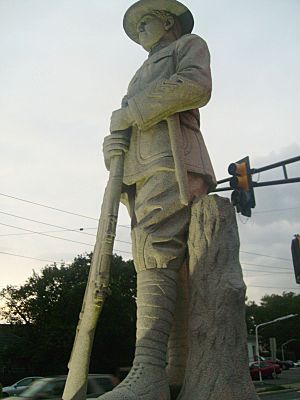
In 1918, Robert Wood Johnson II, who was important to the Johnson & Johnson company, joined the Highland Park Council. He became mayor in 1920. His summer home was on River Road.
Over the years, Highland Park's land was divided into smaller plots for homes. Many planned neighborhoods were built, like Watson Whittlesey's Livingston Manor. It took many years to build all the houses and apartment buildings that make up the borough today.
Highland Park also had some industries in the past, like a brewery and parts of Johnson & Johnson. The Band-Aid was actually invented here! However, by the 1960s, most of the industrial businesses were gone. Today, the shopping areas along Raritan and Woodbridge Avenues are still busy with many local shops.
Highland Park has always focused on its local community, including schools, churches, and town government. This focus on local control continues today.
In 2012, Highland Park was the first town in New Jersey to start a program to help residents save energy at home. This program can help homeowners save up to 30% on their energy bills. In 2016, Highland Park became the state's first "HeartSafe community," meaning it's well-prepared for heart emergencies.
Livingston Manor: A Historic Neighborhood
|
Livingston Homestead
|
|
|
U.S. Historic district
Contributing property |
|
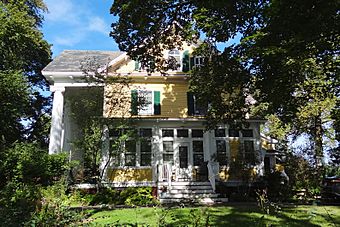 |
|
| Location | 81 Harrison Avenue |
|---|---|
| Architectural style | Greek Revival |
| Part of | Livingston Manor Historic District (ID04000672) |
| NRHP reference No. | 02000215 |
| Significant dates | |
| Added to NRHP | March 20, 2002 |
| Designated CP | July 7, 2004 |
|
Livingston Manor Historic District
|
|
| Location | Parts of Cleveland, Grant, Harrison, Lawrence, Lincoln, Madison, and North Second Avenues and River Road |
|---|---|
| NRHP reference No. | 04000672 |
| Added to NRHP | July 7, 2004 |
The Livingston Manor was a neighborhood built on the land around the Livingston Homestead. Watson Whittlesey, a real estate developer, started this project in 1906. He was known for building communities, not just selling land.
Between 1906 and 1925, Whittlesey's company built many single-family houses. These houses had special designs and showed off the skills of the builders. The neighborhood grew block by block at first. Later, people could choose individual lots to build on.
Many important people from New Brunswick and Highland Park bought homes here. These included college professors, teachers, bank employees, and factory owners. By 1910, 62 houses had been built. By 1913, there were 120 houses.
Whittlesey created a strong community spirit. He held parties for residents and made playgrounds for children. He encouraged men to get involved in town matters. After he passed away in 1914, hundreds of residents attended a memorial service at his house.
The Livingston Manor Historic District was added to the New Jersey Register of Historic Places in 2004. It was also added to the National Register of Historic Places in 2004.
Buildings by Alexander Merchant
Alexander Merchant (1872–1952) was a famous architect who designed many buildings in Highland Park and New Brunswick. Here are some of his designs:
- 55 South Adelaide Avenue (1909)
- Lafayette School on South Second Avenue and Benner Street (original school-1907 and Second Avenue wing-1915). This building is now apartments.
- Reformed Church of Highland Park on South Second Avenue (original church-1897)
- Irving School on Central Avenue (original building-1914)
- The Center School on North Third Avenue (opened 1915)
- The Pomeranz Building on Raritan Avenue and South Third Avenue (1920)
- 82 Harrison Avenue (1913)
- Two houses on Cliff Court (1914)
- Several houses on South Adelaide Avenue near Cliff Court (1910–1914)
- The Highland Park High School (original building-1926)
- The Masonic Temple on Raritan Avenue at North Fourth Avenue (1923). A fire in 1965 damaged the upper levels, and it's now a one-story commercial building.
- The Brody House at the corner of Raritan and North Adelaide Avenues (built 1911, torn down 1997)
- The former Police Station at 137 Raritan Avenue (torn down).
- Anshe Emeth Memorial Temple on Livingston Avenue in New Brunswick (1929)
Highland Park's Location
According to the United States Census Bureau, Highland Park covers a total area of 1.83 square miles (4.74 square kilometers). Most of this is land, with a small amount of water.
The borough got its name because it's on "high land" next to the Raritan River. It has a "park-like" feel and overlooks the city of New Brunswick. Highland Park shares its borders with other towns in Middlesex County: Edison, New Brunswick, and Piscataway.
Highland Park's Population
| Historical population | |||
|---|---|---|---|
| Census | Pop. | %± | |
| 1910 | 1,517 | — | |
| 1920 | 4,866 | 220.8% | |
| 1930 | 8,691 | 78.6% | |
| 1940 | 9,002 | 3.6% | |
| 1950 | 9,721 | 8.0% | |
| 1960 | 11,049 | 13.7% | |
| 1970 | 14,385 | 30.2% | |
| 1980 | 13,396 | −6.9% | |
| 1990 | 13,279 | −0.9% | |
| 2000 | 13,999 | 5.4% | |
| 2010 | 13,982 | −0.1% | |
| 2020 | 15,072 | 7.8% | |
| 2023 (est.) | 14,959 | 7.0% | |
| Population sources: 1910–1920 1910 1910–1930 1940–2000 2000 2010 2020 |
|||
What the 2010 Census Showed
In 2010, the 2010 United States census counted 13,982 people living in Highland Park. There were 5,875 households, and 3,267 families. The population density was about 7,728 people per square mile.
About 21.1% of the people were under 18 years old. The average age in Highland Park was 34.8 years. For every 100 females, there were about 92 males.
Community Life in Highland Park
Highland Park is sometimes called a "bedroom community" for nearby Rutgers University and Johnson & Johnson in New Brunswick. This means many people who work or study there live in Highland Park, giving the town an academic feel. Two Nobel Prize winners, Selman Waksman (Medicine, 1952) and Arno Penzias (Physics, 1978), used to live in the borough.
There's a modern environmental center on River Road. The town's Environmental Commission hopes this center will be a stop on a walking trail along the river. This trail would connect different parks and natural areas.
In 1978, Highland Park became the first town in New Jersey to have an eruv. An eruv is a special boundary that allows Orthodox Jews to do certain activities outdoors on the Sabbath that would normally not be allowed. A continuous wire is strung around parts of the borough. This wire is checked every Friday to make sure it's complete. When it's intact, it helps Orthodox Jewish residents follow their religious rules on the Sabbath.
Schools in Highland Park
The Highland Park Public Schools educate students from pre-kindergarten all the way through twelfth grade. In the 2020–21 school year, the district had about 1,558 students and 145 teachers. This means there were about 10.7 students for every teacher.
The schools in the district are:
- Irving Primary School (Pre-K–1)
- Bartle Elementary School (grades 2–5)
- Highland Park Middle School (grades 6–8)
- Highland Park High School (grades 9–12)
There is also the Greater Brunswick Charter School, which serves students from Highland Park and nearby towns in grades K–8.
Students in eighth grade from all over Middlesex County can apply to special high school programs. These are offered by the Middlesex County Vocational and Technical Schools. They provide career and technical education at different locations.
The Center School helps students with learning and emotional challenges from kindergarten through 12th grade. It moved to Highland Park in 1989.
Getting Around Highland Park
As of 2010, Highland Park had about 31.46 miles of roads. Most of these roads are maintained by the town itself.
Here are the five main roads in Highland Park:
- New Jersey Route 27 – This road is known as Raritan Avenue. It goes through downtown Highland Park for about 1.5 miles.
- County Route 514 – This road joins Route 27 for a bit, then becomes Woodbridge Avenue. It runs through the southeast part of the borough.
- Middlesex County Route 622 – This is River Road. It follows the curve of the Raritan River for over a mile in the western part of town.
- Middlesex County Route 676 – This is Duclos Lane. It forms part of Highland Park's eastern border with Edison.
- Middlesex County Route 692 – This is Cedar Lane in the northern section of the borough.
Larger highways like U.S. Route 1 and New Jersey Route 18 are also very close to Highland Park.
Buses and Trains
NJ Transit provides local bus service on routes 810 and 814. You can also catch weekend bus service to Atlantic City on Suburban Transit's 700 route.
For train travel, NJ Transit trains to Penn Station New York (northbound) and the Trenton Transit Center (southbound) are available at the New Brunswick station and Edison station nearby.
Wildlife in Highland Park
White-tailed deer are often seen in Highland Park. Sometimes, there are so many that they become a bit of a problem. A survey of the deer population was done in 2019 to help the town plan how to manage them.
Famous People from Highland Park
Many interesting people have lived in or are connected to Highland Park, including:
- Adele Astaire (1896–1981), a famous dancer and actress.
- Fred Astaire (1899–1987), a legendary dancer, singer, and actor.
- Jim Axelrod (born 1963), a CBS news correspondent.
- David Clewell (1955–2020), a poet.
- Earle Dickson (1892–1961), the inventor of the Band-Aid.
- Nancy Dorian (1936–2024), a linguist.
- Kirk Douglas (1916–2020), a well-known actor and producer.
- Michael Douglas (born 1944), an actor, director, and producer.
- Samuel G. Freedman, an author and columnist for The New York Times.
- Israel Gelfand (1913–2009), a famous mathematician.
- Rebecca Goldstein (born 1950), an author and philosopher.
- Alan Guth (born 1947), a physicist.
- Dwayne Haskins (1997–2022), an American football quarterback.
- Amy Herzog, a playwright.
- John Hulme (born 1987), an author.
- John Seward Johnson II (1930–2020), a sculptor.
- Robert Wood Johnson II (1893–1968), a Johnson & Johnson President and former mayor of Highland Park.
- Soterios Johnson, a WNYC radio host.
- Seth Kaper-Dale, a pastor and political candidate.
- Sacha Killeya-Jones (born 1998), a basketball player.
- Sheldon Lavin (1932–2023), a CEO and chairman of OSI Group.
- Roy Lichtenstein (1923–1997), a famous pop artist.
- Seth Mandel (born 1982), an author and editor.
- Tomás Eloy Martínez (1934–2010), a journalist and writer.
- Suzy Parker (1932–2003), a fashion model and actress.
- Arno Allan Penzias (1933–2024), a physicist and Nobel Prize winner.
- Susan Pitt (1948–2024), a swimmer and world record-holder.
- Stav Prodromou (born 1944), a businessman.
- George T. Reynolds (1917–2005), a physicist.
- Susana Rotker (1954–2000), a journalist and writer.
- Rudy Rucker (born 1946), a mathematician, computer scientist, and science fiction author.
- Neil Sloane (born 1939), a mathematician.
- L. J. Smith (born 1980), a former NFL tight end.
- Joan Snyder (born 1940), an artist.
- Ulrich P. Strauss (1920–2015), a Rutgers University chemist.
- Darrell K. Sweet (1934–2011), an illustrator.
- Endre Szemerédi (born 1940), a mathematician and Abel Prize winner.
- Norman Tanzman (1918–2004), a politician.
- Olga Von Till (1897–1996), a classical pianist.
- Alan Voorhees (1922–2005), an engineer and urban planner.
- Selman Waksman (1888–1973), a biochemist and Nobel Prize winner for his work on antibiotics.
See also
 In Spanish: Highland Park (Nueva Jersey) para niños
In Spanish: Highland Park (Nueva Jersey) para niños


